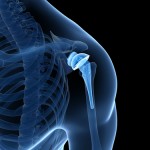
Fractures to the upper arm, also known as proximal humerus fractures are a common fracture in low energy injuries, especially in those with osteoporosis. Many can be treated without surgery, but the most severely displaced, multi-fragmentary fractures may require operative management. Traditionally the operation of choice has been hemiarthroplasty (a ‘half’ shoulder replacement – replacement of humeral head – often discussed as the ‘ball’ of the ball and socket joint).
By comparison, reverse shoulder replacements (a ball placed into the glenoid – the ‘socket’ of the shoulder joint) have been used successfully in older people as an elective procedure for those with osteoarthritis associated with lack of rotator cuff (muscles of the shoulder) function. It has therefore been proposed that some proximal humerus fractures could be treated with reverse shoulder replacements. But what’s the evidence? Schairer et al. from the Hospital for Special Surgery in New York undertook a retrospective study of current practice in the US discover the current trends.
Here’s what they did
This group retrospectively searched the NIS – an American database called the Nationwide Inpatient Survey. This takes a snapshot of inpatient admissions in the US (approximately 20% of all admissions).
They searched the data from 2011 – the first year in the US that reverse shoulder replacement and hemiarthroplasty were separately identified in the database. They searched for patients who had their treatment recorded (coded) as proximal humeral fracture with either hemiarthroplasty or reverse geometry arthroplasty, and then compared the demographics of the patients included and their outcomes.
Here’s what they found
There were 7714 patients who had either procedure for fracture in the database: 2113 (27.4%) underwent reverse shoulder replacement, 5604 (72.6%) underwent hemiarthroplasty.
Age: Those undergoing reverse shoulder replacement were significantly older (76.1years ± 17.4 versus 71.5 ±13.4; P<0.001), but there was no difference in gender or comorbidity status between the 2 groups.
Multivariate analysis concluded that age significantly increased the likelihood of undergoing a reverse arthroplasty (odds ration 1.7; p<0.001).
Elective v emergency: The majority of the reverse shoulder replacements were undertaken as elective (planned) procedures. This was a significant difference to hemiarthroplasty, where the procedure was split between being an elective and an emergency procedure (66% versus 50%; p<0.001).
Hospital setting: There was no difference between surgery undertaken in teaching hospitals versus smaller hospitals, but there was a significant difference between the rate of reverse shoulder arthroplasty undertaken in rural hospitals (15.1 vs 10.3% p<0.001), in government run hospitals (13.8 versus 7.5% P<0.001), and in centres that undertake higher volumes of reverse shoulder replacements (odds ratio 27.84 95% CI 16.30-40.96; p<0.001).
Complications: There was no significant difference in the rate of systemic complications (e.g. pneumonia, MI, PE; (5.3% for reverse versus 6.4% for hemi; p=0.229) or local complications (wound infection, dehiscence; 2.7% reverse versus 1.66% for hemi; p=0.236) between the 2 procedures, although there was a significantly longer length of stay in hospital seen for those having hemiarthroplasty (4.27 days for reverse vs 3.9; p=0.042) with patients more likely to be directly discharged home following hemiarthroplasty than reverse (29.6% versus 41.6% p<0.001).
The authors concluded
Although hemiarthroplasty remains the most common arthroplasty choice for proximal humerus fractures, reverse shoulder arthroplasty is becoming widely used. Patient characteristics and complications were similar between the 2 procedures.

It is likely that acceptance of reverse shoulder arthroplasty will continue to grow
The Musculoskeletal Elf’s view

This retrospective review noted that rates of short-term complications were equivalent in the two procedures, and emphasises that there is an increased acceptance and use of reverse shoulder replacement for the treatment of fractures in the US. This was especially seen in rural and government lead centres, when reverse geometry arthroplasty was used as a planned procedure. The group appreciated that the study relied on how procedures were recorded by individual hospitals, and that the factors affecting a surgeon’s decisions remained most important.
This study is valuable in showing us the trends in fracture treatment in the US. It is a shame that the information recorded in the database doesn’t give us any information about the types of fractures that were treated with surgery or how decisions were reached. The study describes short-term outcomes, but more work into longer-term outcome measures such as pain and function would enable us to make better decisions in future.
This research opens a wider debate about new surgical techniques and how and where we introduce them. What stops some things from becoming commonplace? What makes some centres want to try novel techniques? How do we encourage work into building expertise and evidence in new techniques whilst ensuring patient safety? These are all questions we will have to think more about as surgery continues to advance.
What do you think?
- How should we decide when a surgical technique is best practice?
- How should we approach regional variation in practice?
Send us your views on this blog and become part of the ever expanding Musculoskeletal Elf community. Post your comment below, or get in touch via social media (Facebook, Twitter, LinkedIn, Google+).
Links
- Schairer WW, Nwachukwu BU, Lyman S, Craig EV, Gulotta LV.J Reverse shoulder arthroplasty versus hemiarthroplasty for treatment of proximal humerus fractures. Shoulder Elbow Surg. 2015 May 7. pii: S1058-2746(15)00159-7. doi: 10.1016/j.jse.2015.03.018. [abstract]
- BESS – British Elbow and Shoulder Society
- Arthritis UK – shoulder and elbow joint replacement
- PRISMA statement
- EQUATOR Network

What is the trend in surgery for proximal humerus fractures? http://t.co/Txla6pA6ez
@MSK_Elf http://t.co/bWIMkXQAgJ PROFHER trial, a different view